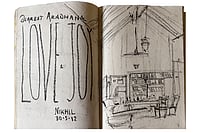“I saw a raindrop, once, on the hood of a car in a used car dealership, just that one shining drop, but it had everything around it. In it, all of the other cars and pickups, every red, yellow and blue plastic pennant flapping above it, a row of newly planted saplings standing in line by the highway with bandaged trunks and saggy guy-wires, the whining traffic and the sky overhead that was looking more and more like rain, four or five swallows darting within it.”
— From Raindrop by Ted Kooser
I drive around cities looking at the world from inside out. For the sake of notes. For the sake of stories. That night I asked my friend if he would drive me around Mumbai. “I just want to see how the rains fall,” I had said. “Take photos of the rain. See everything from the inside out.” Like how Kooser would say in the next line of the poem—one drop of rain had taken in everything. All of the world is in a raindrop perhaps. What I didn’t say was that I wanted to remember. And I have always remembered better when it is raining.
A raindrop has everything around it, in it and more. That night in Mumbai, it was pouring. I found her where the road curved. Through the car window, my face pressed against the glass, I saw her against the backdrop of the omnipresent blue construction sheets, the white cast of the girl had her hands stretched upwards with dozens of teacups stuck to her dress. Was she collecting raindrops in this city of perpetual construction with that apocalyptic fervour where boxlike apartment buildings are making everyone estranged?
She had once been part of a tea place. They left her on the side of the road when they shut shop. I called her “Dissolved Girl”, which is the title of a song I like to listen to when it rains.
I once had imagined Persephone gathering raindrops by the sea, looking upwards, a cat by her side, rescuing raindrops from falling on the earth. This is a place of acid rain. In 1974, scientists had first reported acid rain in Trombay. But even acid can’t match the erosion of trust here.
A raindrop is a portal, too. Someone once told me about the worst floods in Patna in 1975 when the water discharge from the Sone was 14.48 lakh cusec. I wasn’t born then. People had been stranded on their roofs, she said. She was a little girl then. One day, people tore up shirts, sheets and anything black and made flags and waved them in protest.
The then prime minister was doing an aerial survey that day. The little girl had asked her father why people did that. He had said because people were sad. That sadness of being abandoned on rooftops later manifested into the works of Bihar-based artist Shambhavi Singh who told me this story.
ALSO READ: Monsoons And The Interpreter Of Melodies
The rain is agony, too. Every year, we hear stories of floods. People die, escape and starve. Every year, aerial surveys happen. I wonder if people can protest anymore like they did then. With black flags.
***
As we drove around Mumbai that night in the rains, I asked my friend if the rains are a lament of all betrayals. He said they could be tears of happiness. But that kind of downpour is a dirge. Happiness is never that abundant.
A raindrop can take in everything. It can take you everywhere. Even to places that don’t exist anymore. Like my grandfather’s old house, with its green walls where he drank rum and read Matthew Arnold’s Dover Beach. That’s how I first began to imagine the sea in that old mofussil town called Ara. Everything there begins with the rains. The cups on the cast of that giant girl are the cups placed in the corridors to collect the raindrops that found their way through the cracks in the ancient walls. Everything is a metaphor for something.
***
“The Sea of Faith
Was once, too, at the full, and round earth’s shore
Lay like the folds of a bright girdle furled.
But now I only hear
Its melancholy, long, and withdrawing roar,
Retreating, to the breath
Of the night-wind, down the vast edges drear
And naked shingles of the world,” wrote Matthew Arnold in Dover Beach. My grandfather said it was about the recession of faith. When it rains, I always return to that poem.
Raindrops can be triggers of memories. I remember a sad, lonely beach place during the rains from long ago. The empty porticoes, the shuttered shops, the red flags on the beaches, and the grey seas howling. A place like Goa. Those windows that were once shut opened to blue seas and lovers whispering poems to each other. Along with the litter, echoes and the sea glistening in the moonlight, singing a strange song about abandonment. When it rains, the sea becomes a bit bolder to vomit the foam onto the concrete streets. In some places, rivers swell. They change their course. They ravage and kill. In other places, people dream of rain.
Presence and absence can be both blissful and lethal. This issue is dedicated to rain memories, those diamond absolutes where a writer remembers the bullfrogs from his childhood. He thought they were some kind of orchestra. Another remembers the Kosi, the river we call the Sorrow of Bihar. And a poet has written about the people of Anantapur who know nothing about rain.
And all of this and more came from a poem where the poet said one drop of rain had taken in everything.
This issue is an ode to that raindrop. There are stories from that place called ‘inside out’, where absence and presence collide and become a song of love and loss. That’s what the rains do. They make us see. Like I saw the Dissolved Girl that night.


























